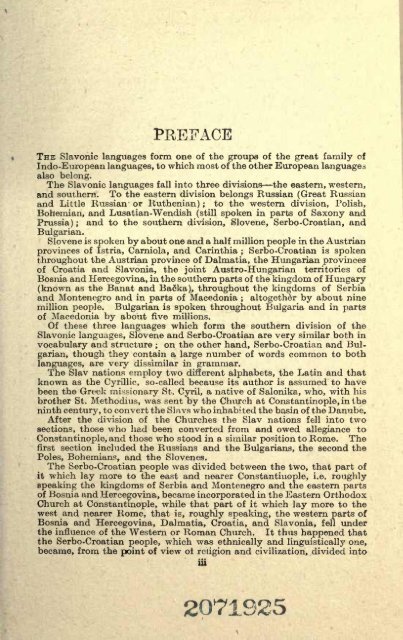- Page 1: alifornia 'ional lity SERBIAN-ENGLI
- Page 8 and 9: Iv PREFACE two halves, which came t
- Page 11 and 12: SERBIAN-ENGLISH baba : f., grandmot
- Page 13 and 14: cs] bes : m., rage, fury hydrophobi
- Page 15 and 16: a] (bud bratski : adj., fraternal,
- Page 17 and 18: ven] venae : m., garland, wreath ve
- Page 19 and 20: vre] vr, ;i (vrim) : to boil vrz .
- Page 21 and 22: D, da: conj., that, in order that,
- Page 23 and 24: dom] 15 [dud domacin : m., master o
- Page 25 and 26: fen] 17 [zaj ienski : adj., feminin
- Page 27 and 28: zgo] 19 [Izv zgoda : f., opportunit
- Page 29 and 30: istj 21 [jel istorija : f., history
- Page 31 and 32: kalj 23 fkis kaldrma : f . , paved
- Page 33 and 34: kon] 25 [kri konac (-nca) : m., cot
- Page 35 and 36: lab] 27 [Hs L, JI. labud : m., swan
- Page 37 and 38: 29 [mar f., anger, rage, *, oii^ii,
- Page 39 and 40: mil] 31 [mok milost : f., grace, in
- Page 41 and 42: na] 33 [nap na : prep., to, on, in,
- Page 43 and 44: nez] 35 [ties nezadovoljnost : f.,
- Page 45 and 46: nodj nociti : to spend the night no
- Page 47 and 48: odg] odgovoran, -rna, -rno : adj.,
- Page 49 and 50: OS] os : m., osa, f., wasp osam : n
- Page 51 and 52: pak] [pas : paklina f.. tar pakovat
- Page 53 and 54: pec] 45 [pla : pecenica f., peSenka
- Page 55 and 56: plj] pljusak : m., shower, rain-sto
- Page 57 and 58:
poz] 49 [pol pozan, -zna, -zno : ad
- Page 59 and 60:
ponj 61 [pos ponovo : adv., again,
- Page 61 and 62:
pot] 53 [pra potuiiti se : to i : c
- Page 63 and 64:
pre] predvidjenje thought : predgra
- Page 65 and 66:
pri] 67 [pro prilican, -6na, -6no :
- Page 67 and 68:
proj 59 [psa i prostak : m. .common
- Page 69 and 70:
puc] 61 [rad pudi (puknem) : burst,
- Page 71 and 72:
az] 63 [ras razloino : adv., sensib
- Page 73 and 74:
ca] 65 [rit realka : f., modern (re
- Page 75 and 76:
ud] 67 [sav ruclilo : n., curling t
- Page 77 and 78:
6am] 69 [sas i samard2ija: m., pack
- Page 79 and 80:
sve] 71 [svii svestan, -stna, -stno
- Page 81 and 82:
going down ; a prestola, abdi- cati
- Page 83 and 84:
sla] 75 slavoluk : m., triumphal ar
- Page 85 and 86:
smr] 77 [spo smreka : f., juniper s
- Page 87 and 88:
sro] 79 [sto srp : m., sickle, star
- Page 89 and 90:
sud] 81 [taj sudjen, -a, -o : adj.,
- Page 91 and 92:
tek] 83 [top tek, tekar : adv., har
- Page 93 and 94:
tro] 85 [tuc' trojak, -a, -o : adj.
- Page 95 and 96:
ubo] 87 [udr j ubojit, -a, -o : adj
- Page 97 and 98:
ule] uledi : (ulegnem) to enter uli
- Page 99 and 100:
ute] [ust uteha : f., consolation,
- Page 101 and 102:
hal] 93 [hoi : haluga f., abyss, go
- Page 103 and 104:
cen] 95 [cad cenik : m., price-list
- Page 105 and 106:
^es] 97 Cestitanje : n., congratula
- Page 107 and 108:
Sam] 99 [Slj Samlica : f., stool sa
- Page 109 and 110:
Dav] 101 IRos Davorin : m., Martin
- Page 111:
Sko] 103 fSt, : Skoplje n., Uskub S
- Page 114 and 115:
abs] 106 [ack absolutism : n., apso
- Page 116 and 117:
adu] adulterate : v., kvariti adult
- Page 118 and 119:
alo] 110 [ang aloud : adv., glasno,
- Page 120 and 121:
app] 112 [art appointment : n., nal
- Page 122 and 123:
ath] 114 [avo atheist : n., bezboin
- Page 124 and 125:
an] 116 [bea bandit : m., razbojnik
- Page 126 and 127:
el] bellows : n., mehovi, m., pi. :
- Page 128 and 129:
fcla] 120 [bod blaspheme : v., huli
- Page 130 and 131:
ow] 122 [bre bow : n., luk, m. ; (c
- Page 132 and 133:
o] 124 [bur brow: n., obrva, f . ;
- Page 134 and 135:
cal] 126 [cap calf : n., tele (tele
- Page 136 and 137:
cas] 128 [cen cashier: n., blagajni
- Page 138 and 139:
cha] 130 [chl zaStita, f. ; free of
- Page 140 and 141:
cis] 132 [ell cistern : n., cistern
- Page 142 and 143:
cob] 134 [col cobalt : n., kobalt,
- Page 144 and 145:
com] 136 [com poveriti ; to writing
- Page 146 and 147:
con] 138 [con confectionery : n. f
- Page 148 and 149:
con] 140 [cor control: v., kontroli
- Page 150 and 151:
era] 142 [cru crack : n., pucanje,
- Page 152 and 153:
cut] 144 [dec cutlass : n., kratka
- Page 154 and 155:
dem] 146 [dif demolition : n., poru
- Page 156 and 157:
dis] 148 [dom dismay : n., bojailjv
- Page 158 and 159:
dro] frowned person : n., utopljeni
- Page 160 and 161:
ena] 152 [equ enamel : v., ocakliti
- Page 162 and 163:
exc] 164 [fal exchange : v., razmen
- Page 164 and 165:
fee] 156 [fir feet (pi. od foot) :
- Page 166 and 167:
foa] 108 [for foam : n., pena, f. f
- Page 168 and 169:
fri] fright frighten : n., strah, u
- Page 170 and 171:
gen] gentleness : n., neznost, blag
- Page 172 and 173:
gra] 164 [gro gradual : adj., postu
- Page 174 and 175:
habj 166 fhar haberdasher : n., sit
- Page 176 and 177:
hea] 168 [hel headache : n., glavob
- Page 178 and 179:
in] 170 [hor hinder : v., smetati(s
- Page 180 and 181:
un] hundred : num. Bto, n. ; stotin
- Page 182 and 183:
Imp] 174 [imp impassive: adj., neos
- Page 184 and 185:
Inc] 178 {inf incorrect j adj., net
- Page 186 and 187:
ins] 178 [Int inseparable: adj., ne
- Page 188 and 189:
Irr] 180 [jol irreverent: adj., bez
- Page 190 and 191:
ket] 182 [lab kettle : n., kotao -t
- Page 192 and 193:
lau] 184 [leg laudanum : n., prec'i
- Page 194 and 195:
lik] 186 [loc . like: v., voleti (-
- Page 196 and 197:
mac] 188 [man macaroni : m., pi. ma
- Page 198 and 199:
mat] 190 [men mat : n., rogozina, a
- Page 200 and 201:
mln] 192 [mon mint (flower) : n., m
- Page 202 and 203:
mun] 194 [nee : municipality n., op
- Page 204 and 205:
noc] 196 [nym nocturnal : adj., noc
- Page 206 and 207:
oft] 198 on je otisao ; far , vrlo
- Page 208 and 209:
out] 200 [pac ours, jedan od nasih
- Page 210 and 211:
par] 202 fpau : parlour n., soba, f
- Page 212 and 213:
per] 204 [Pic periodical: adj., per
- Page 214 and 215:
Pla] plain : n., ravnica, f. ; polj
- Page 216 and 217:
pos] 208 [pre 1 direk, stub kolac,
- Page 218 and 219:
prl] 210 [pro robijaS, m. ; (war) z
- Page 220 and 221:
pup] 212 [qua pitomac (-mca), m. ;
- Page 222 and 223:
al] 214 [rea ieleznici, f. ; bridge
- Page 224 and 225:
ed] 216 [rcl Redskin, n., erven koz
- Page 226 and 227:
es] 218 [rib resin : n., smola, f.
- Page 228 and 229:
ol] 220 [run roll : v., valjati, ko
- Page 230 and 231:
sal] 222 [sch salted : adj., posolj
- Page 232 and 233:
sec] 224 [seq class, druga klasa, f
- Page 234 and 235:
sha] 226 [sho bridak, ostrljat, iil
- Page 236 and 237:
silj 228 [ski silver : n., srebro,
- Page 238 and 239:
Smo] [sol smokeless : adj., bezdimn
- Page 240 and 241:
sou] 232 [spl souvenir : n., uspome
- Page 242 and 243:
starlight, n. ; zvezdana svetlost,
- Page 244 and 245:
SUV] 236 [stu store : v., kupiti, s
- Page 246 and 247:
sue] 238 [sup sucking-child (baby)
- Page 248 and 249:
swa] 240 [tab swarm : v., rojiti se
- Page 250 and 251:
tea] 242 ftha tears, okupan u suzam
- Page 252 and 253:
tho] thoroughfare : n., veliki drum
- Page 254 and 255:
tol] 246 [tow tolerance : n., trpim
- Page 256 and 257:
tra] 248 [tro on foot, peSke ; on h
- Page 258 and 259:
fur] 250 [unb redomice ; it is my ,
- Page 260 and 261:
und] 252 [unl underwear : n., rublj
- Page 262 and 263:
upp] 254 [vai table, metni na stol
- Page 264 and 265:
venj venom : n., otrov, m. venomous
- Page 266 and 267:
vol] volley : n., paljba, f. ; puca
- Page 268 and 269:
wat] 260 [wed water-bottle : n., Su
- Page 270 and 271:
whe] 262 [win whether: conj., da li
- Page 272 and 273:
won] 264 [wri wonder : v., cuditi s
- Page 274 and 275:
266 [Boc : zigzag n., cikcak, in. z
- Page 276:
Phi] I'hilippopolis, : Plovdin, ra.
- Page 279 and 280:
3 1158 01078 5003 A 000 064 105 o

















